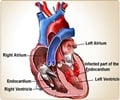A potential molecular playbook for blocking cardiac hypertrophy, the unwanted enlargement of the heart and a well-known precursor of heart failure has been discovered by researchers

The new research is a concept study in the very early stages of investigation and has yet to be examined in animal models.
Still, it represents a new avenue of exploration for scientists working to find ways to prevent and treat cardiac hypertrophy and heart failure.
"While our findings are still in the beginning phases, they are important because heart failure is a major cause of human disease and death, and it remains very hard to treat. One of the main treatments for heart failure, beta blockers, has huge side effects, such as increased fatigue and depression, so scientists need to continue to look for new ways to care for patients with the disease," said Dr. Zheng-Gen Jin, associate professor within the Aab Cardiovascular Research Institute at the Medical Center and lead author of the study.
The playbook begins with a key protein, histone deacetylase 5, or HDAC5, one of several proteins that influences gene expression - the process by which genes are turned on and converted into proteins that carry out the body's functions.
The location of HDAC5, in conjunction with other factors, helps determine whether or not gene expression takes place- If HDAC5 is pushed outside the nucleus, genes are turned on and proteins are made, but if it remains inside the nucleus genes are suppressed.
Advertisement
Researchers also believe PKA helps counteract stress signals, such as from high blood pressure, which interact with and typically boot HDAC5 out of the nucleus, clearing the way for the expression of cardiac growth genes and the subsequent development of heart muscle cells that lead to the enlargement of the heart.
Advertisement
The most common cause of hypertrophy is hypertension, or high blood pressure, which forces the heart to work harder to pump blood throughout the body, causing the muscle to thicken over time.
When the heart is enlarged, it does not work as efficiently as it should and can lead to heart failure.
According to Jin, next steps include animal studies to determine if keeping HDAC5 in the nucleus through PKA signalling stops cardiac hypertrophy in mice.
Findings may reveal the HDAC5/PKA interaction as a viable target for drug therapy to treat cardiac hypertrophy and heart failure. Researchers have filed a patent application for the concept that is currently pending.
"Jin and his team have defined a new, potentially drugable target for treating cardiac hypertrophy, yet much more research is needed to determine if the findings hold beyond the current study," said Dr. Joseph Miano, associate director of the Aab Cardiovascular Research Institute.
The study has been published in Proceedings of the National Academy of Sciences.
Source-ANI














